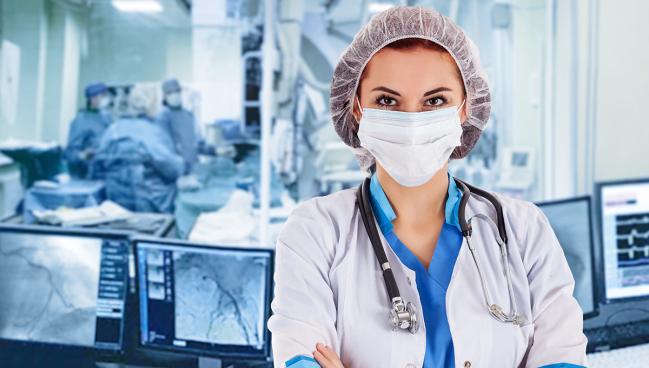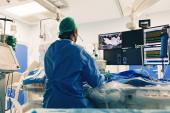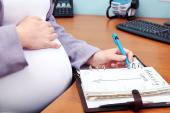Risk of Radiation Low for Pregnant Operators When Precautions Taken
Women needn’t avoid the cath lab if they don’t want to, according to a new review that says risks to a fetus are very small.

There isn’t a lot of evidence regarding the risks of radiation exposure to interventional cardiologists, interventional radiologists, and electrophysiologists who are pregnant, but the available data suggest the risk of harm is small, according to a new review.
While women often don’t work in the labs once they become pregnant—the level of allowable radiation during pregnancy varies around the world and can preclude them from even practicing once pregnant—experts believe it is possible to work without harming the developing fetus.
“The instinct today is that whenever somebody is pregnant, whether it’s a technologist, nurse, or physician, they are not allowed to enter the cath lab,” said senior author Ariel Roguin, MD, PhD (Hillel Yaffe Medical Center/Technion—Israel Institute of Technology, Hadera). “When you look at the literature, and you see what the numbers are, we may be exaggerating [the risk]. . . . It’s an area of missing data, so the regulations are cautious because that’s preferred rather than allowing everybody to be exposed.”
For example, there are no studies looking at the risk of spontaneous abortion of women working in the cath lab and none documenting the risk of other adverse events, such as fetal or birth defects. Exposure to high doses of radiation can cause birth defects, malformations, and intellectual impairments, but at doses nearly 10 times higher than safety limits recommended by the American College of Obstetricians and Gynecologists and the National Council on Radiation Protection and Measurements (NCRP), according to the review. Studies of children born to radiologic technologists have not shown any heightened risk of cancer compared with the general population.
To TCTMD, Roguin pointed out that 50% of all medical students are women, and their numbers are increasing every year. While more than 40% of internal medicine trainees are female, women make up just 23% of cardiology fellowships. When looking at fields involving fluoroscopically guided interventions, such as interventional radiology, interventional cardiology, and electrophysiology, their numbers drop off even further.
“It’s really rare to see a woman in the cath lab,” said Roguin, noting they have to plan their training and careers around a pregnancy that can take them away from the cath lab for at least a year. “We have many women who have to take this into account, about when to plan their family, and they aren’t sure if they should have the child now or wait. It’s a major issue. Women are great doctors, and we’re lacking them in the cath lab.”
Overlapping Skirts, Aprons on Patients
In the US, the NCRP recommends limiting occupational exposure of the fetus to 5 mSv or less during the entire pregnancy (or 0.5 mSv per month). In the UK and Norway, though, the levels of allowable radiation during pregnancy are so low that female operators aren’t able to practice during gestation. Elsewhere in Europe, the fetal dose limit is 1 mSv or less for the entire pregnancy.
Despite the limited safety data, there is evidence from dosimeters worn by operators during pregnancy that suggest minimal risks during gestation.
In a Spanish case series of four interventional cardiologists and one electrophysiologist, operators showed that with additional protection, which included overlapping layers of the lead skirt over the abdomen, the risk of exposing the fetus to ionizing radiation was “virtually negligible.” One retrospective study of a fellow who performed neurointerventional procedures before and after pregnancy found there was zero fetal radiation exposure with two lead apron skirts, all without significant changes in the fellow’s case volume or fluoroscopy time.
The reviewers point out that advances in x-ray machines, mapping systems in electrophysiology, and increasing awareness have led to significant declines in radiation doses over time. In one study of electrophysiology procedures, for example, the annual recorded occupational doses declined by approximately 70% for both physicians and nurses.
As part of the review, which was led by Majdi Saada, MD (Hillel Yaffe Medical Center/Technion—Israel Institute of Technology), the authors propose several strategies to protect against radiation during pregnancy in the cath lab. These include a focus on minimizing fluoroscopy times and using technologies, specifically in electrophysiology, that allow operators to perform procedures without radiation. Low frame rates, low magnification, and use of short, intermittent radiation instead of continuous radiation are also recommended. They advise using all possible protection devices, including ancillary shields—ceiling-mounted screens, table curtains, lead skirts over the patient’s waist, and a mobile floor shield—during the procedure.
“Protection from radiation is always good,” said Roguin. “It doesn’t matter your gender, or if you’re pregnant or not. From the report we saw in Spain, where they use double layers of lead skirts, which aren’t as heavy, is something [for pregnant operators] to consider. Also, something that’s very simple is based on a study we did where we put a lead apron on the patient. This lead apron can reduce radiation to the operator by 50% or more.”
The also recommend using at least two dosimeters during pregnancy, one on the trunk (chest level) inside the lead apron and one at the collar or left shoulder outside the apron. Use of third dosimeter inside the lead apron at the abdomen is also recommended, if possible. During pregnancy, the most valuable information is from the dosimeters worn inside the lead apron, according to the reviewers.
Roguin emphasized that there is a need for future research, including long-term follow-up data on exposed health professionals and their children. Additionally, there is a need for prospective follow-up studies looking at the influence of radiation on fertility and spontaneous abortions, as well as on small birth weight, birth defects, learning disabilities, and cancer in the offspring. Additional studies in men are also warranted, such as the effect of radiation dose on conception, fertility, and child health, particularly in the 3 months prior to conception.
Michael O’Riordan is the Managing Editor for TCTMD. He completed his undergraduate degrees at Queen’s University in Kingston, ON, and…
Read Full BioSources
Saada M, Sanchez-Jimenez E, Roguin A. Risk of ionizing radiation in pregnancy: just a myth or real concern. Europace. 2022;Epub ahead of print.
Disclosures
- The authors report no relevant conflicts of interest.





Comments